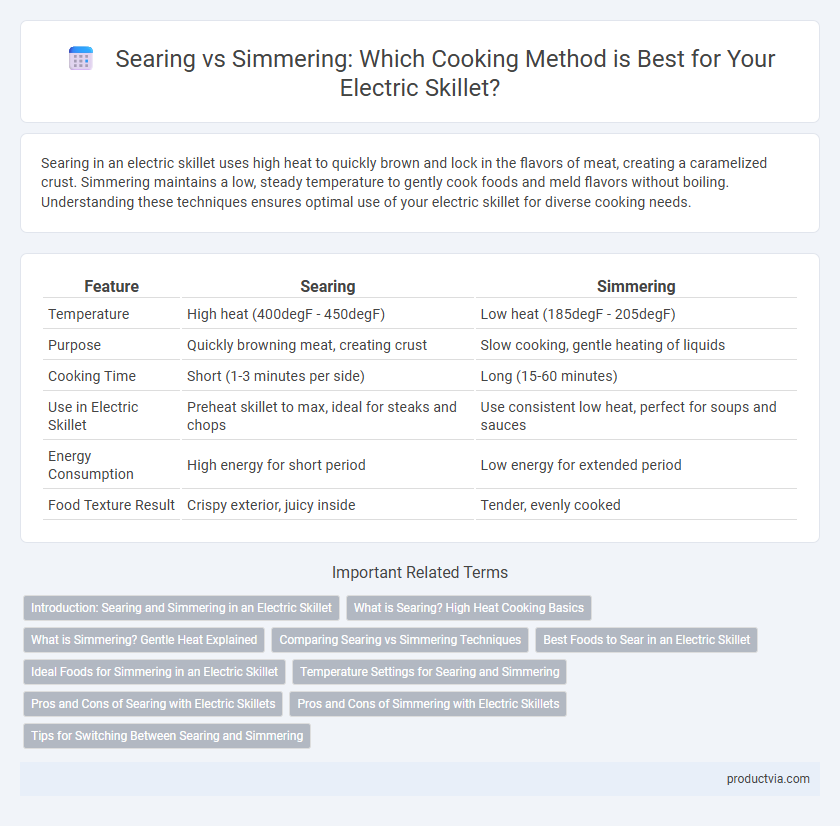Searing in an electric skillet uses high heat to quickly brown and lock in the flavors of meat, creating a caramelized crust. Simmering maintains a low, steady temperature to gently cook foods and meld flavors without boiling. Understanding these techniques ensures optimal use of your electric skillet for diverse cooking needs.
Table of Comparison
| Feature | Searing | Simmering |
|---|---|---|
| Temperature | High heat (400degF - 450degF) | Low heat (185degF - 205degF) |
| Purpose | Quickly browning meat, creating crust | Slow cooking, gentle heating of liquids |
| Cooking Time | Short (1-3 minutes per side) | Long (15-60 minutes) |
| Use in Electric Skillet | Preheat skillet to max, ideal for steaks and chops | Use consistent low heat, perfect for soups and sauces |
| Energy Consumption | High energy for short period | Low energy for extended period |
| Food Texture Result | Crispy exterior, juicy inside | Tender, evenly cooked |
Introduction: Searing and Simmering in an Electric Skillet
Searing in an electric skillet involves cooking food at high temperatures, typically between 400degF and 450degF, to create a caramelized crust that locks in juices and enhances flavor. Simmering requires maintaining a lower temperature, generally around 185degF to 205degF, to gently cook ingredients and develop rich, layered tastes without boiling. Mastering these temperature controls in an electric skillet optimizes cooking versatility, making it ideal for both quick browning and slow, tender simmering.
What is Searing? High Heat Cooking Basics
Searing in an electric skillet involves cooking food at high temperatures, typically between 400degF and 500degF, to create a caramelized crust that locks in juices and enhances flavor. This high-heat technique requires preheating the skillet to its maximum temperature before adding food, ensuring a quick Maillard reaction on the surface. Proper searing results in a golden-brown exterior while maintaining a tender interior, ideal for meats and vegetables.
What is Simmering? Gentle Heat Explained
Simmering in an electric skillet involves maintaining a steady heat of around 185degF to 205degF, just below boiling point, to gently cook food without vigorous bubbling. This method allows flavors to meld and tenderizes ingredients over time, ideal for soups, stews, and sauces. The electric skillet's adjustable thermostat provides precise temperature control, ensuring consistent simmering without scorching.
Comparing Searing vs Simmering Techniques
Searing in an electric skillet uses high heat, typically around 400degF to 450degF, to quickly brown the surface of meats, locking in juices and enhancing flavor through the Maillard reaction. Simmering, by contrast, involves maintaining a lower temperature, usually between 185degF and 205degF, allowing ingredients to cook gently in liquids without boiling, ideal for soups, stews, and delicate sauces. Understanding the temperature control and heat distribution of your electric skillet ensures optimal results when choosing between searing and simmering techniques.
Best Foods to Sear in an Electric Skillet
Electric skillets excel at searing meats like steak, chicken breasts, and pork chops due to their consistent high heat and even heat distribution, which creates a flavorful, caramelized crust. Vegetables such as bell peppers, mushrooms, and asparagus also benefit from searing in an electric skillet, enhancing their natural sweetness and texture. For optimal results, preheat the skillet to around 400degF to ensure a perfect sear that locks in moisture and flavor.
Ideal Foods for Simmering in an Electric Skillet
Simmering in an electric skillet is ideal for cooking delicate foods like sauces, soups, and stews that require gentle, consistent heat to develop flavors without burning. Foods such as braised meats, chili, and vegetables benefit from the controlled low temperature that prevents overcooking. This method allows for even heat distribution, making it perfect for slow-cooked dishes that need to retain moisture and tenderness.
Temperature Settings for Searing and Simmering
Electric skillets offer precise temperature control, with searing typically set between 400degF to 450degF to achieve high heat for browning meats and creating a flavorful crust. Simmering requires a lower temperature range of 180degF to 200degF, allowing gentle cooking that prevents boiling and preserves delicate flavors. Adjusting the temperature dial accurately ensures optimal results for both high-heat searing and low-heat simmering in electric skillets.
Pros and Cons of Searing with Electric Skillets
Searing with an electric skillet offers high, consistent heat that locks in juices and creates a flavorful crust, enhancing the taste and texture of meats. However, the main cons include potential uneven heat distribution in lower-quality models and the risk of smoke due to prolonged high temperatures. Electric skillets excel at maintaining steady temperatures, making them ideal for searing but requiring good ventilation and careful monitoring to prevent burning or smoke buildup.
Pros and Cons of Simmering with Electric Skillets
Simmering with an electric skillet offers precise temperature control, ensuring consistent low heat ideal for delicate sauces and slow-cooked meals, which helps prevent burning and uneven cooking. However, some electric skillets may struggle to maintain true simmer temperatures due to their heating element design, potentially causing fluctuations that can affect dish texture. The convenience of simmering in an electric skillet complements its fast heating capabilities but may require occasional monitoring to achieve optimal results.
Tips for Switching Between Searing and Simmering
To switch effectively between searing and simmering in an electric skillet, adjust the temperature setting promptly from high (around 400degF) for searing to low or medium-low (around 200degF) for simmering. Preheat the skillet fully before searing to achieve a crisp, brown crust, then reduce heat gradually to maintain gentle simmering without scorching. Use a lid when simmering to retain moisture and intensify flavors while preventing evaporation.
Searing vs Simmering for Electric Skillet Infographic

 productvia.com
productvia.com